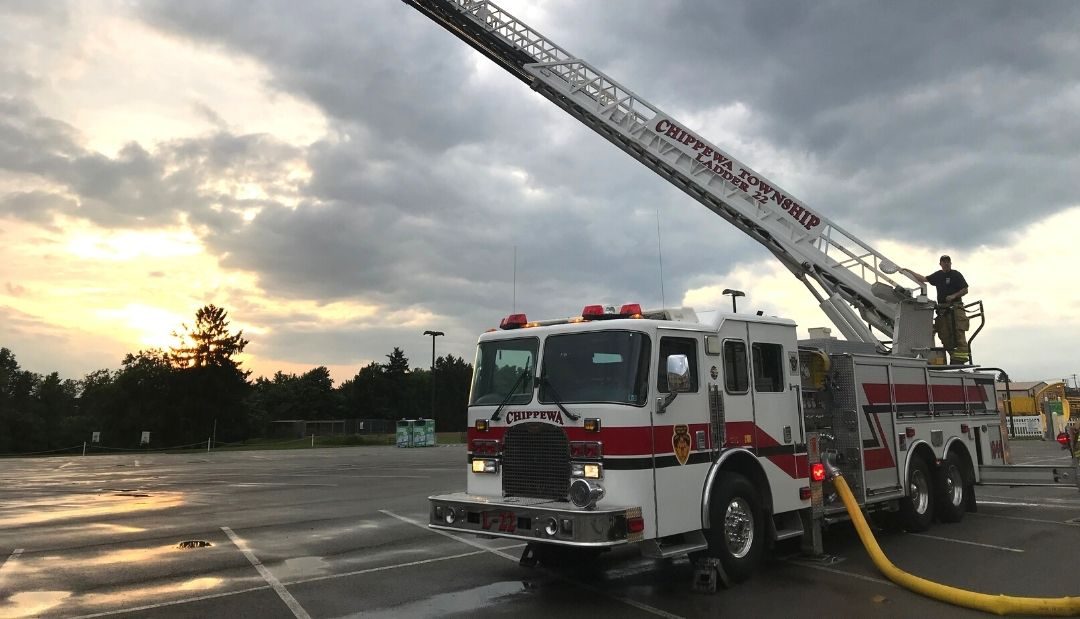Submitted by David M. Przybysz, Assistant Chief / President
In past issues we have discussed a bunch of different topics from how the Chippewa Fire Department came into existence to whom our members are. From safety tips for nearly every season to how we had to change our operations to navigate through the novel coronavirus called COVID-19.
In this issue, we’d like to share with you some vital statistics concerning the volunteer fire departments not only here at home but across the country.
The very first volunteer fire department was formed right here in Pennsylvania! With 40 buckets, some ladders and some hooks purchased by the city of Philadelphia, the Union Volunteer Fire Company was formed in 1736. One of its founding members was none other than Benjamin Franklin!
The bucket brigades are a far cry from today’s fire service with its diesel-powered trucks, fire resistant gear and computer aided dispatches.
According to the NFPA, in 2018 there were approximately one million, one hundred and fifteen firefighters in the United States.
The National Fire Protection Association (NFPA) was founded in 1896. It is a self-funded, non-profit organization dedicated to reducing death, injury, property and economic losses due to fire and other related incidents and still exists today.
The NFPA has spent years developing guidelines and standards for just about all aspects of firefighting including equipment, apparatus, gear, training and many others. Just about anything that a fire department purchases today that directly deals with fire safety meets or exceeds NFPA standards. This ensures that the equipment we use, the gear we wear and even the trucks we ride in are built for the severe duty that we could encounter on any given emergency call.
The NFPA reports that of those one million plus firefighters, 67% are all volunteer just like we are in Chippewa! The rest are made up of solely career departments like you find in the major cities across the country and combination departments, departments that have full and part time paid staff supported by their own volunteers. Such is the case in cities like Beaver Falls and Ambridge.
At one time, Volunteer departments were the backbone of American firefighters. They save municipalities and taxpayers over $140 billion a year but, since 1986, the number of all volunteer departments has declined by over 10%. As costs and training requirements continue to increase, many smaller departments are absorbed by larger or paid departments that have the means to keep up with the industries increases. In the last 30 years, fire protection costs have risen over 135%!
Chippewa operates one fire engine, one rescue truck, one 100’ ladder truck, one EMS squad, one brush fire response truck and a large pick-up truck used to respond to structure fire strike team calls throughout the county as well as to pull our technical rescue trailer to specialized rescue calls throughout the region. Our Chief also drives a department owned vehicle, allowing him to respond directly to the scene and establish command of the situation.
Fire trucks aren’t cheap! An Engine can cost anywhere from $500,000 – $750,000. A Rescue the size we have can easily cost $800,000 and an aerial truck, well over one million dollars!
We have 25 members on our roster but not all 25 answer every call, and not all members are trained to the same level. Training requirements, work schedules and other obligations often restrict the number of members answering a call down to just a handful.
Although Pennsylvania does not mandate training for firefighters, most fire departments realize the liability of operating with untrained personnel. The basic firefighting training course is called the Essentials of Firefighting. Divided into four modules, it starts with the history of firefighting and basic skills and progresses to the final module, a live fire structure burn session. This consists of over 120 hours of classroom and practical training exercises.
The natural progression is to then achieve the nationally recognized Firefighter I certification which takes countless hours of practice and studying. There is a written test that must be passed as well as a day full of pass/fail skill stations.
There are countless other certificates that can be obtained in all aspects of the fire service. Most are taught locally but many require weeks or weekends at the state fire academy in Lewistown, PA.
On the medical side, training can run anywhere from 50 hours for a Emergency Medical Responder (EMR) to over 250 hours for an Emergency Medical Technician (EMT). Paramedic certifications can require over 1400 hours of training.
We are fortunate that many of our members are certified in one aspect or another and several hold multiple certificates. Currently we have four EMR’s, five EMT’s and three Paramedics. We also have seven members who have achieved their Firefighter One and six are certified to the level of Firefighter Two!
We have approximately ten members that are certified Basic Vehicle Rescue Technicians and many with more advanced rescue certificates. We also have one member that received their Fire Officer One and Fire Instructor One and one who has achieved Fire Officer Two and Fire Instructor Two.
An impressive list, for sure and there are several other certifications that we didn’t even mention!
And let’s not forget that each of these dedicated members participated in the necessary classes and trainings to achieve their certifications and to perfect their skills while holding down regular full-time jobs and taking care of their family obligations!
So, as you can see, it’s not easy to be a volunteer. The public depends on us not only to show up when we’re needed but to show up in numbers and to know what we’re doing when we get there! This is why you will see multiple fire companies responding to emergencies. Most volunteer companies simply can’t do it on their own. Society has changed and people simply don’t have the drive or the time to dedicate to such an important and demanding craft. As our numbers continue to drop, volunteer departments, nationally continue to look for new ways to recruit, train and provide qualified emergency responders.
As you can see, money is only one of many issues plaguing the volunteer fire service. Eliminating or downsizing emergency services is obviously not a good solution. Many communities don’t want to give up their hometown fire departments and understandably so.
The thought of possibly one day not having any fire department isn’t acceptable either.
Some communities have considered merging their departments. Departments that have already done so have seen positive results such as lower overhead costs, more consistent training and a reduction in duplicate equipment.
There are some negatives as well. Change is uncomfortable for many. In some cases, departments have actually lost some members in the process. Some departments may be asked to give up their identity, to run under a new name and form a fresh start. Sometimes municipalities can’t agree on the financial figures. And, sometimes merging departments have trouble agreeing on the brand or type of equipment or gear that should be used.
So, how do we do it here in Chippewa?
As you can tell, it’s no easy task. First of all, we have a strong working relationship with all of our surrounding departments. No matter what the need, additional manpower, more apparatus or for somebody to simply stand by in case we get multiple calls, our mutual aid departments never let us down.
Secondly, our community strongly supports us. Whether it is by attending our fundraisers, contributing to our donation requests or dropping off food or bottled water, the support we get from our residents and businesses is absolutely incredible! Even though we sometimes have to block a road or otherwise inconvenience you on occasion, you always let us know that in the end, we are appreciated.
Lastly, having a good working relationship with our municipal leaders is a big part of our existence. They know we are essential. They know the issues we are facing and while none of us have the answer, our township supervisors and management team stand bedside us. They support us and work with us on a continuous basis.
With that kind of support, we are able to provide some of the best emergency response in the county. As our township continues to grow, we consistently review our tactics and our response plans. It is our intention to be here for you now, tomorrow and long into the future, serving you and our surrounding communities just as we have since 1927!
Keep up the good work, Chippewa! We will be here when you need us!







